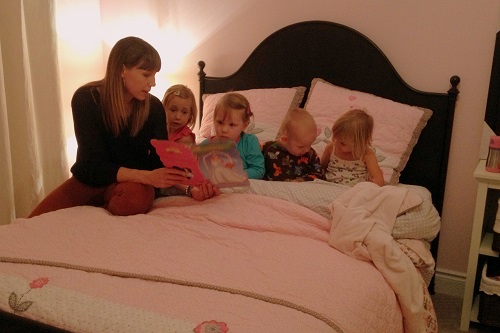 Why Reading Aloud to Our Children Will Change Their Lives Forever
Why Reading Aloud to Our Children Will Change Their Lives Forever

Part 4 of our Soothing Routine Series
Would you believe me if I told you there was a simple way to help your child transition from a busy day to a restful night, help them perform well academically, entertain and intrigue their mind, all while strengthening the bonds between parent and child? Oh, and it’s entirely free.
Too good to be true? Think again. Reading out loud to your children accomplishes each and every one of these objectives.
It sounds simple. It is simple. The results are astounding. Reading to our children does not just calm down the littles before bedtime, but gives them a head start academically, fosters a relationship between parents and their kids and perhaps most importantly, promotes a life long love of books and reading.
“Reading aloud to children is the single most important activity for building knowledge required for eventual success in reading.” (National Academy of Education’s Commission on Reading, 1985).
By reading to our kids;
– We build better neural pathways (stimulating thought, creativity and imagination),
– We bring knowledge (books are full of new, diverse and unique experiences),
– We help develop language skills (simply by being exposed to more words),
– Promote early literacy skills (a child who is read to will understand the seemingly easy approach of left to right and top to bottom, retell a story, memorize lines, understand context),
– Offer a physical and emotional closeness through a shared experience (tell me your child doesn’t enjoy being cuddled and held while reading a story?),
– And encourage a joy of reading. “Every time we read to a child, we’re sending a ‘pleasure’ message to the child’s brain. . . you could even call it a commercial, conditioning the child to associate books and print with pleasure.” (Trelease, 1982).
Experts recommend reading aloud to your child as soon as he or she is born, and continuing indefinitely go to these guys. If you don’t do this yet, fortunately, it’s never too late to start. While the investments are few: just your time and a library card, the benefits are many. Always remember that a good book is meant to be enjoyed; not just for the purpose of making good readers, but for enriching lives.
“The fire of literacy is created by the emotional sparks between a child, the book, and the person reading.”
~ Mem Fox
References:
Trelease, Jim. “The Read-Aloud Handbook.” Penguin, 1982.
Fox, Mem. “Reading Magic: Why Reading Aloud to Our Children Will Change Their Lives Forever.” Harcourt, 2001.
Graphic. Read Aloud 15-Minutes www.readaloud.org.
More information:
10 Commandments for Reading Aloud
Read Aloud.org
Dolly Parton’s Imagination Library
Reading Rockets
Bedtime Stories to Read Aloud
 Krista is a wife, mother of 2 (+1 Vizsla), Certified Sleep Coach, closeted iron chef, marathoner, e-commerce aficionado and wannabe interior designer. When she’s not helping families go from tired to terrific, she loves reading aloud to her children (and only skips the occasional page).
Krista is a wife, mother of 2 (+1 Vizsla), Certified Sleep Coach, closeted iron chef, marathoner, e-commerce aficionado and wannabe interior designer. When she’s not helping families go from tired to terrific, she loves reading aloud to her children (and only skips the occasional page).


 Finding Tranquility with Belly Breathing
Finding Tranquility with Belly Breathing Amanda DeGrace, President & Founder of
Amanda DeGrace, President & Founder of